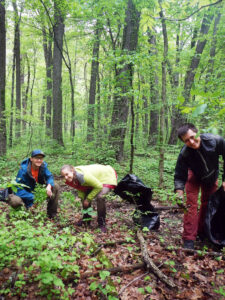
Volunteers smile while they spend a busy day pulling garlic mustard from a Wisconsin forested area. Volunteers provide thousands of hours of annual help in the fight against invasive plant species. / Photo Credit: Wisconsin DNR
By Mackenzie Manicki, Wisconsin DNR Invasive Plants Specialist
Mackenzie.Manicki@wisconsin.gov or 608-206-4561
June is Invasive Species Action Month in Wisconsin. This tradition of spreading awareness and taking action began back in 2005.
Twenty years ago, the Wisconsin Invasive Species Council collaborated with partners such as the Wisconsin Department of Natural Resources (DNR) and the Invasive Plants Association of Wisconsin (IPAW) to hold the first Invasive Species Action Awards, aimed at recognizing and celebrating professional or volunteer groups and individuals that exemplify what it means to make an impact on invasive species.
Some may wonder what the big deal is. Why do we need a whole month to raise awareness about invasive species? Why do we distribute awards for folks who work to challenge their expansion? Well, invasive species are a pervasive, ever-present threat, and their impacts are multifaceted.
In Wisconsin, invasive species are defined as non-native species that harm the environment, economy or human health. We often hear about the ecological impacts of invasive species, as they can create dense monocultures that crowd out native vegetation and degrade wildlife habitat. However, there’s more to the story.
Here are some examples of the many ways invasive species can impact all Wisconsinites:
- Environmental: They displace native species, alter soil nutrients, increase risks of erosion and increase risks of flooding.
- Economic: They decrease agricultural yields, decrease tree regeneration, damage infrastructure and increase utility costs.
- Human health: Some are toxic to touch or ingest, some can cause physical injury due to spines or thorns and some provide habitat and protection for disease vectors such as ticks.
Recognizing the problems posed by these species prompted the Wisconsin State Legislature to grant the DNR the authority to create and enforce rules to manage invasive species.
To assist with this, the Wisconsin Invasive Species Council was established in 2002. In 2009, the first version of Wisconsin’s Invasive Species Identification, Classification and Control Rule (ch. NR40 Wis. Admin. Code) was codified into law. This rule makes it unlawful to transport, transfer, introduce or possess regulated invasive species, with some exceptions.
Establishing the rule is only one piece of the invasive species puzzle. The Council and its partners recognized the need to raise awareness and reward the hardworking people out there making a difference. Hence, Invasive Species Action Month and the Invasive Species Action Awards were born.
Tips And Resources
Learning from previous Action Award winners, here are some ways we can all make a difference this June and beyond:
- Learn about invasive species. Get to know what species are prevalent in your area and how you can prevent their spread. The DNR has webpages for regulated invasive species in Wisconsin.
- Control invasive species when feasible. Once you know what species you’re dealing with, you can learn how to manage it on your property. The University of Wisconsin-Madison Renz Weed Science Lab offers detailed online resources on controlling many common invasive plants.
- Take preventative measures when recreating. Thoroughly clean all your gear (shoes, pants, tires, boat, dog, etc.) before leaving an outdoor recreation site for the day. The DNR offers details and tips about preventative measures.
- Plant native species whenever possible. Native plants are beautiful, hardy and often play well together in a garden, saving you time, money and a large headache if you had planted an invasive. The DNR offers many resources on planting native plants.
- Get involved. Interested people are encouraged to join a volunteer group or help a local Cooperative Invasive Species Management Area (CISMA). The DNR offers information about events and volunteer opportunities and details about Wisconsin’s CISMA groups.
